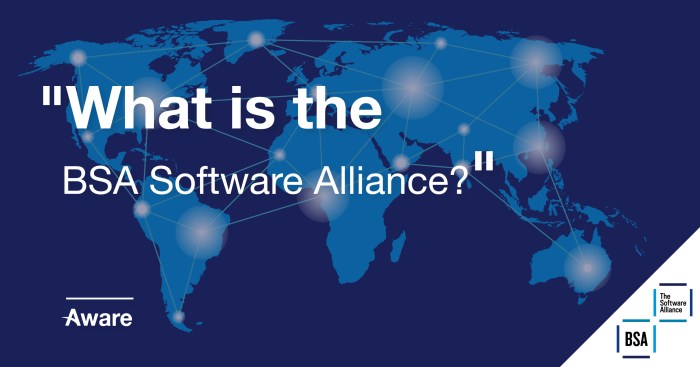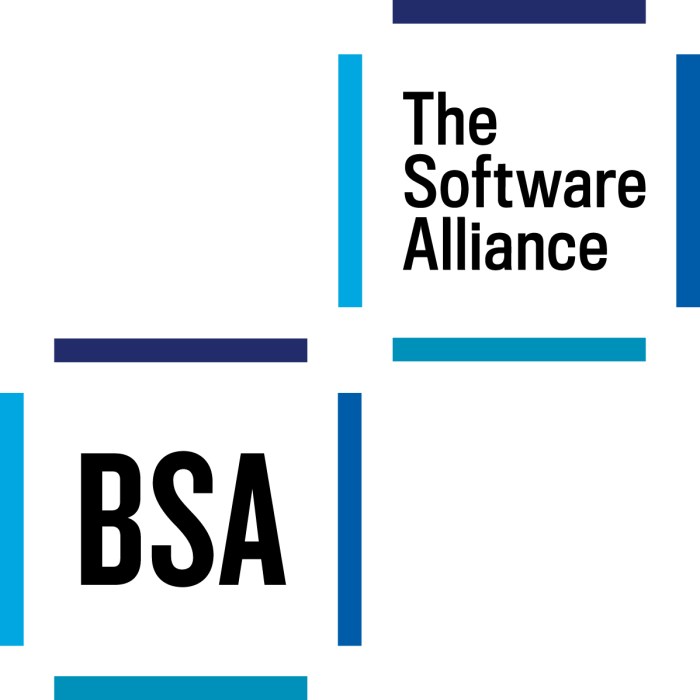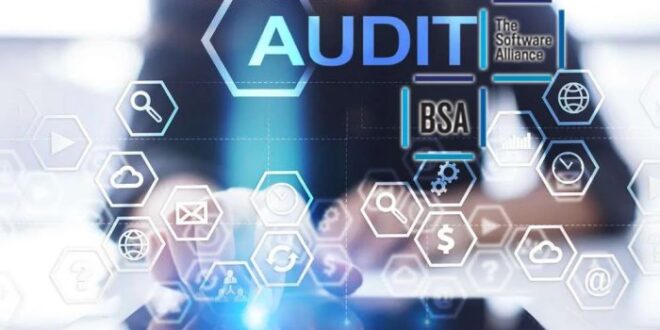In the ever-evolving landscape of software licensing, organizations must navigate the complexities of Business Software Alliance (BSA) audits. These audits, conducted by the BSA, aim to ensure compliance with software licensing agreements and protect intellectual property rights. Understanding the process, methodologies, and implications of BSA audits is crucial for organizations seeking to mitigate risks and maintain a strong compliance posture.
BSA audits delve into an organization’s software usage, examining compliance with licensing terms. The findings of these audits can have significant consequences, ranging from fines and legal action to reputational damage. However, by implementing robust software asset management practices, organizations can proactively prepare for BSA audits and minimize their potential impact.
Business Software Alliance Audits
The Business Software Alliance (BSA) is a non-profit organization that represents the global software industry. BSA’s mission is to promote the legal and ethical use of software and to protect the intellectual property rights of its members. BSA audits are a key part of its efforts to combat software piracy.
BSA audits are designed to identify and address instances of software piracy. Piracy occurs when someone uses software without a valid license. This can include using unlicensed copies of software, using software beyond the terms of a license, or distributing pirated software.
Purpose of BSA Audits
BSA audits serve several purposes, including:
- To deter software piracy
- To identify and address instances of software piracy
- To educate businesses about the risks of software piracy
- To promote the legal and ethical use of software
Scope of BSA Audits
BSA audits can be conducted at any business that uses software. The scope of an audit will vary depending on the size and complexity of the business. However, all BSA audits will typically include the following steps:
- Review of software licenses
- Inventory of software installed on computers
- Comparison of licenses to installed software
- Identification of any unlicensed software
- Reporting of findings to the business
BSA Audit Process

A BSA audit is a comprehensive review of a company’s software usage to ensure compliance with software licensing agreements. The process typically involves the following steps:
The BSA audit process is designed to ensure that companies are using software in compliance with their licensing agreements. By following these steps, companies can avoid the risk of legal action and financial penalties.
Preparation
The preparation phase involves gathering information about the company’s software usage. This information can be collected from a variety of sources, including software inventory tools, purchase records, and employee interviews.
Data Collection
The data collection phase involves collecting data about the company’s software usage. This data can be collected through a variety of methods, including software audits, manual inspections, and interviews with employees.
Analysis
The analysis phase involves analyzing the data collected during the data collection phase. This analysis can be used to identify any discrepancies between the company’s software usage and its licensing agreements.
Reporting
The reporting phase involves preparing a report that summarizes the findings of the audit. This report can be used by the company to identify any areas of non-compliance and to develop a plan to address these issues.
BSA Audit Methodology
BSA utilizes a comprehensive methodology to conduct audits, combining statistical sampling, forensic analysis, and interviews to effectively assess software compliance within organizations.
The methodology is designed to provide a thorough and accurate evaluation of software usage, ensuring that organizations are compliant with licensing agreements and industry best practices.
Statistical Sampling
BSA employs statistical sampling techniques to select a representative sample of devices within an organization for software verification. This sampling approach allows auditors to make inferences about the entire software population based on the analysis of the sample.
- Benefits: Statistical sampling provides cost-effectiveness and efficiency, allowing auditors to evaluate a smaller sample size while maintaining a high level of accuracy.
- Considerations: The sample size and selection process are carefully determined to ensure that the sample is representative and provides reliable results.
Forensic Analysis
BSA utilizes forensic analysis techniques to examine software usage patterns and identify potential software piracy. Forensic analysis involves examining software installation logs, license keys, and other data to uncover evidence of unauthorized software usage.
- Benefits: Forensic analysis provides detailed insights into software usage and can detect sophisticated attempts to circumvent licensing compliance.
- Considerations: Forensic analysis can be time-consuming and requires specialized expertise.
Interviews
BSA conducts interviews with IT staff and other personnel within organizations to gather information about software usage and compliance practices. Interviews help auditors understand the organization’s software management processes and identify areas where improvements can be made.
- Benefits: Interviews provide valuable qualitative insights and can help auditors gain a deeper understanding of the organization’s software environment.
- Considerations: Interviews can be time-consuming and require the cooperation of the organization’s personnel.
BSA Audit Findings and Implications

BSA audits typically reveal a range of findings, including:
Software Compliance Violations
These violations occur when software is used without proper licensing or in violation of the license agreement. Common examples include:
- Using unlicensed software
- Using software on more devices than permitted
- Using software for purposes not covered by the license
Under-licensing
This occurs when an organization has fewer licenses than the number of devices or users accessing the software. Under-licensing can result in software compliance violations and legal action.
Over-licensing
This occurs when an organization has more licenses than necessary. While over-licensing is not a legal violation, it can indicate inefficient software management and wasted resources.
Potential Consequences of BSA Audit Findings
BSA audit findings can have significant consequences for organizations, including:
- Fines: BSA can impose substantial fines for software compliance violations.
- Legal action: BSA may pursue legal action against organizations that repeatedly violate software licenses.
- Reputational damage: BSA audit findings can damage an organization’s reputation and make it difficult to attract new customers and partners.
Preparing for a BSA Audit

BSA audits are comprehensive software audits conducted by the Business Software Alliance (BSA) to ensure that organizations are using licensed software and complying with copyright laws. Organizations can prepare for a BSA audit by implementing effective software asset management (SAM) practices, maintaining accurate software records, and conducting regular self-audits.
Organizations can also prepare for a BSA audit by establishing a software asset management program that includes the following elements:
Establishing a Software Asset Management Program
- Inventory of all software assets, including both installed and uninstalled software.
- Process for tracking software usage and licenses.
- Policy for software procurement and deployment.
- Procedure for software disposal and destruction.
By implementing these measures, organizations can ensure that they are using licensed software and complying with copyright laws, which can help them avoid potential legal and financial penalties.
Maintaining Accurate Software Records
Organizations should also maintain accurate software records, including invoices, purchase orders, and license agreements. These records should be kept in a secure location and be easily accessible in the event of a BSA audit.
Conducting Self-Audits
Organizations can also prepare for a BSA audit by conducting regular self-audits. Self-audits can help organizations identify any potential software compliance issues and take corrective action before a BSA audit is conducted.
BSA Audit Best Practices
Organizations can mitigate risks associated with BSA audits by adopting the following best practices:
Implementing Strong Software Licensing Policies
Establish clear software licensing policies that define the authorized use of software and ensure compliance with license agreements.
- Document software usage rights, including the number of licenses purchased, the terms of use, and the authorized users.
- Implement a software inventory system to track software usage and identify unauthorized installations.
- Regularly review software licenses to ensure compliance and update policies as needed.
Using Automated Software Asset Management Tools
Leverage automated software asset management (SAM) tools to streamline software inventory, license compliance, and usage tracking.
- SAM tools can automatically scan networks for installed software, identify unlicensed software, and track software usage.
- They provide real-time visibility into software assets, enabling organizations to make informed decisions about software procurement and compliance.
- SAM tools can also generate reports and alerts to help organizations monitor compliance and identify potential risks.
Establishing Relationships with Software Vendors
Building strong relationships with software vendors can facilitate open communication and collaboration in the event of an audit.
- Establish clear communication channels with software vendors and keep them informed of software usage.
- Collaborate with vendors to develop customized solutions for software licensing and compliance.
- Seek vendor support and guidance in preparing for and responding to BSA audits.
Closing Summary
BSA audits serve as a reminder of the importance of software licensing compliance. By adhering to best practices, organizations can safeguard their operations, protect their reputation, and avoid costly penalties. Embracing a proactive approach to software asset management and fostering collaboration with software vendors is essential for organizations seeking to navigate the complexities of BSA audits and maintain a competitive edge in today’s digital landscape.

